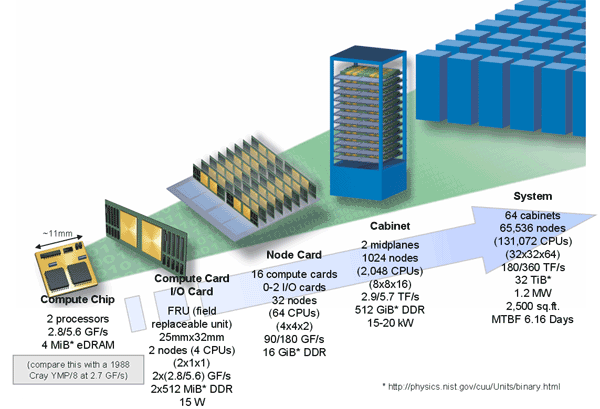CNK operating system on:
[Wikipedia]
[Google]
[Amazon]
 Compute Node Kernel (CNK) is the node level
Compute Node Kernel (CNK) is the node level
 Compute Node Kernel (CNK) is the node level
Compute Node Kernel (CNK) is the node level operating system
An operating system (OS) is system software that manages computer hardware, software resources, and provides common daemon (computing), services for computer programs.
Time-sharing operating systems scheduler (computing), schedule tasks for ef ...
for the IBM Blue Gene
Blue Gene is an IBM project aimed at designing supercomputers that can reach operating speeds in the petaFLOPS (PFLOPS) range, with low power consumption.
The project created three generations of supercomputers, Blue Gene/L, Blue Gene/P, ...
series of supercomputer
A supercomputer is a computer with a high level of performance as compared to a general-purpose computer. The performance of a supercomputer is commonly measured in floating-point operations per second ( FLOPS) instead of million instructio ...
s.''Euro-Par 2004 Parallel Processing: 10th International Euro-Par Conference'' 2004, by Marco Danelutto, Marco Vanneschi and Domenico Laforenza pages 835''Euro-Par 2006 Parallel Processing: 12th International Euro-Par Conference'', 2006, by Wolfgang E. Nagel, Wolfgang V. Walter and Wolfgang Lehner page
The compute nodes of the Blue Gene family of supercomputers run ''Compute Node Kernel'' (CNK), a lightweight kernel that runs on each node and supports one application running for one user on that node. To maximize operating efficiency, the design of CNK was kept simple and minimal. It was implemented in about 5,000 lines of C++
C++ (pronounced "C plus plus") is a high-level general-purpose programming language created by Danish computer scientist Bjarne Stroustrup as an extension of the C programming language, or "C with Classes". The language has expanded significan ...
code. Physical memory is statically mapped and the CNK neither needs nor provides scheduling or context switching, given that at each point it runs one application for one user. By not allowing virtual memory or multi-tasking, the design of CNK aimed to devote as many cycles as possible to application processing. CNK does not even implement file input/output
In computing, input/output (I/O, or informally io or IO) is the communication between an information processing system, such as a computer, and the outside world, possibly a human or another information processing system. Inputs are the signals ...
(I/O) on the compute node, but delegates that to dedicated I/O nodes.
The I/O nodes of the Blue Gene supercomputers run a different operating system: ''I/O Node Kernel'' ( INK). INK is based on a modified Linux kernel
The Linux kernel is a free and open-source, monolithic, modular, multitasking, Unix-like operating system kernel. It was originally authored in 1991 by Linus Torvalds for his i386-based PC, and it was soon adopted as the kernel for the GNU ...
.
See also
* Catamount (operating system) *Compute Node Linux
Compute Node Linux (CNL) is a runtime environment based on the Linux kernel for the Cray XT3, Cray XT4, Cray XT5, Cray XT6, Cray XE6 and Cray XK6 supercomputer systems based on SUSE Linux Enterprise Server. CNL forms part of the Cray Linux ...
* INK (operating system)
INK (for I/O Node Kernel) is the operating system that runs on the input output nodes of the IBM Blue Gene supercomputer.''Euro-Par 2004 Parallel Processing: 10th International Euro-Par Conference'' 2004, by Marco Danelutto, Marco Vanneschi and Do ...
* Rocks Cluster Distribution
Rocks Cluster Distribution (originally NPACI Rocks) is a Linux distribution intended for high-performance computing (HPC) clusters. It was started by National Partnership for Advanced Computational Infrastructure and the San Diego Supercompute ...
* Timeline of operating systems
References
Supercomputer operating systems {{Operating-system-stub